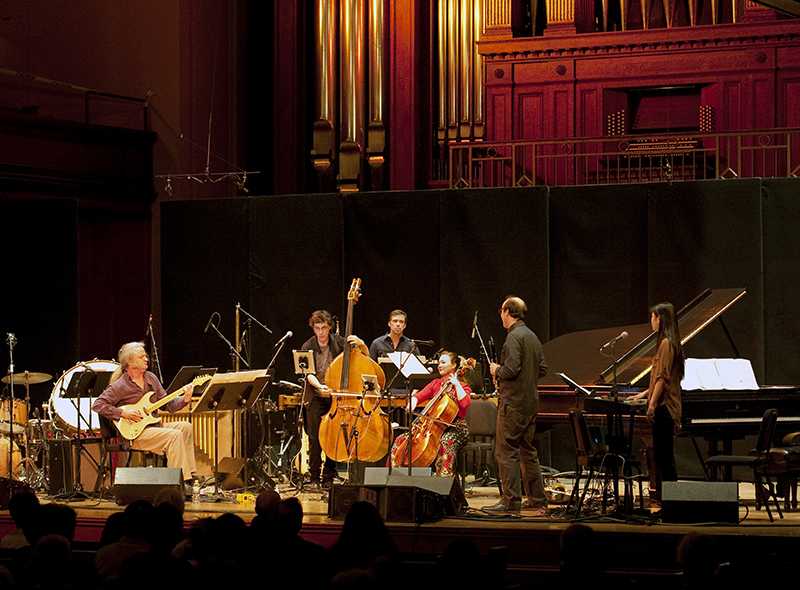New Music Ensemble ‘Adds Echoes’ to Finney Chapel
The Bang on a Can All-Stars treat their audience to a cohesive concoction of musical styles. The iconic collective returned to Finney Chapel last weekend for a lively performance.
March 6, 2015
One by one, the members of the Bang on a Can All-Stars added their voices to the sonic texture of Julia Wolfe’s “Believing,” their wordless humming contrasting sublimely with aggressively rhythmic instrumentals. Each voice was unique in timbre and register, but as the ensemble’s sound engineer Jamie McElhinney adjusted the balances between microphones, the All-Stars’ voices blended together in an unearthly harmony that was both unsettling and profoundly beautiful. “Believing,” the second work in Saturday’s installment of the Artist Recital Series program, finished abruptly; the sudden silence in Finney Chapel was just as jarring as the unusual construction of the music.
Formed in 1992, the Bang on a Can All-Stars deliberately blur the boundaries between different genres of music to stay on the cutting edge of musical innovation. With elements of rock, jazz, experimental and world music, among other styles, the All-Stars are supporters of contemporary music; they regularly commission and perform new works composed specifically for their distinctive ensemble, which comprises cellist Ashley Bathgate, bassist Robert Black, pianist Vicky Chow, percussionist David Cossin, electric guitarist Mark Stewart and clarinetist and saxophonist Ken Thomson.
On Saturday, the group opened with David Lang’s “Sunray.” The piece began with a delicate, gossamer texture entirely in the treble register, as irregular rhythmic patterns flowed seamlessly into one another. There was no discernible melody. Instead, the All-Stars successively highlighted each member of the ensemble by incrementally adjusting their dynamics. At times, Chow’s piano playing seemed to ground the music, while at other times Stewart’s guitar could be heard most distinctly.
The stage was lit for the first part of the concert by warm red and gold spotlights. This contributed to the gentle fire of “Sunray.” The piece gained energy and the All-Stars began to shift focus more rapidly from instrument to instrument, maintaining a sound that was balanced and yet centered on one performer at a time. As the musicians began to accelerate towards the finale, more and more of the ensemble began to play in unison, skillfully combining their energy into a single melodic pattern. As Cossin became more and more dynamic, his wild gestures both conveyed his enthusiasm for the music and kept the players in time before the piece ended with a final snap.
Concerning her piece, “Ridgeway,” Kate Moore wrote, “The piece is a tribute to the journey going back to the point of origin in one’s life. Life is about searching for identity and place.” The music indicated this search through extremely complex and irregular rhythmic patterns. It seemed to search for a comfortable meter which it never quite found. With expressions of fierce concentration, the All-Stars gamely fought through these difficult patterns, but in the end, the piece lacked the laser-like precision of the other works on the program.
After Moore’s more aggressive composition, the spotlights changed to a cool blue, providing a visual indication of the more relaxed nature of the next pieces. Michael Gordon’s “For Madeline” featured a light ostinato based on a major third in the piano line; Chow wove her repetitive figure with the rest of the All-Stars’ sound masterfully, always present, but never overshadowing more prominent melodic lines. Bathgate and Black played with a similar delicacy, their parallel glissandi on cello and bass introducing an instability to the work that contrasted with Thomson’s simple melody. Rather than crescendoing to a final burst like the works on the first half of the concert, “For Madeline” faded out slowly, leaving only Thomson sustaining a soft note on the clarinet until even his sound died away.
Stewart acted as the spokesperson for the group throughout, introducing each work and commenting on the group’s goal as a contemporary ensemble. He said that Bang on a Can had played once before in Finney in the 1990s and that the group was excited to play at Oberlin again. “We’re happy to be here and add some echoes to this lovely hall,” he said.
“Horses of Instruction” by Steve Martland was certainly memorable. Cossin set up an exuberant, mambo-esque beat in the drums before the ensemble introduced the principal melodic motifs. Thomson, who switched to saxophone for this work, bandied a cheerful tune back and forth with the rest of the ensemble, his excitement manifesting as he hopped up and down around the stage. If Martland’s music was a little too long, or the final segment dragged out a touch too far, Stewart and Bathgate’s enthusiasm certainly made up for the music’s repetitiveness, their expressions flickering between serene happiness and amusement as they watched Thomson’s jubilant hopping.
After the spotlights switched back to a warmer tone, Bang on a Can revealed that they had saved the best for last. Though similar to “Sunray” in its delicate rhythmic patterns, Philip Glass’ “Closing” featured more straightforward figures, their cyclic nature allowing attendees to relax. With plaintive but gentle solos on both the guitar and piano, the All-Stars performed “Closing” with flawless technique and just the right amount of phrasing to keep the repetitious piece interesting without ruining its minimalistic aura. After finishing the work, the All-Stars waited with bowed heads as the audience took in the beauty of Glass’ writing for a moment before erupting into enthusiastic applause. Bang on a Can’s performance struck a balance between the cutting-edge and the familiar in a way that few, if any, other contemporary ensembles achieve.


























